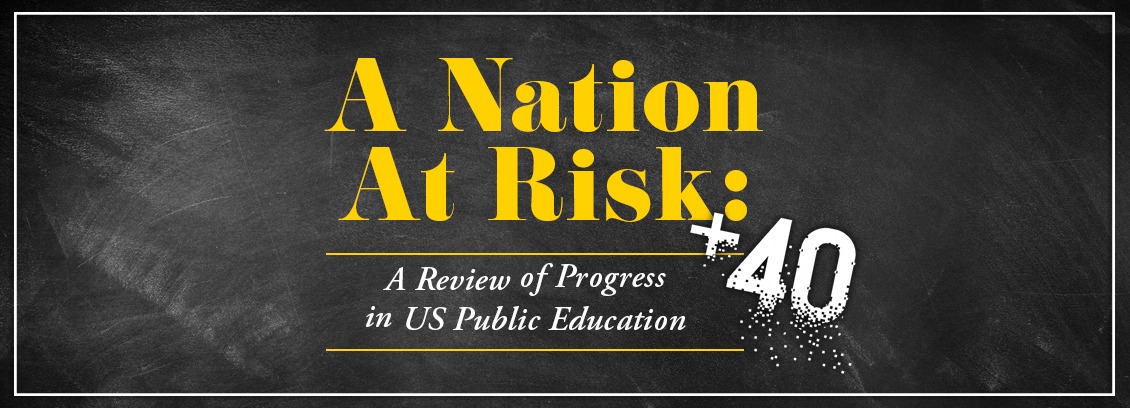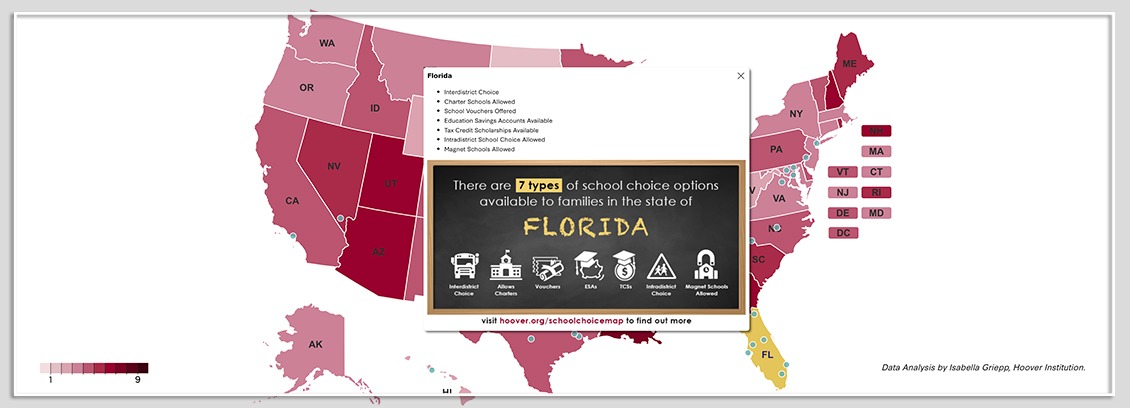
In recognition of the 13th annual School Choice Week (January 22–28), the Hoover Institution highlights the successes and availability of charter schools, alternative education financing arrangements, and other nontraditional schooling methods in various jurisdictions across America. In addition, Hoover fellows have published a new volume that reflects on 40 years of education policy reform since the 1983 release of the landmark public education report A Nation at Risk.
FEATURED ANALYSIS

Evolution of School Choice across America
Hoover Education Success Initiative (HESI) director Stephen Bowen hosted a roundtable discussion on January 17 with colleagues Corey DeAngelis, Anna J. Egalite, and John D. Singleton, outlining new developments in the availability, funding, and growth of school choice across the United States. Bowen said last year could have been “the biggest year” for developments in school choice nationally.
The four spoke of how there are a growing number of states offering all households the chance to enroll in charter or private schools using public dollars, and a growing effort to equalize public support for families whose children are enrolled in charter schools alongside those in traditional public schools.
Click here to watch the entire discussion.
HIGHLIGHTS

School Choice as a Response to A Nation at Risk
In the Hoover Institution’s new volume A Nation at Risk +40, education policy experts assess the impact of various school reforms enacted since the original report’s release in 1983.
A chapter authored by visiting fellow John Singleton in the new volume focuses on the expansion of school choice in the United States over the course of four decades.
The chapter specifically assesses the impact of school choice on the quality of existing traditional public schools. Singleton describes how the introduction of charter schools often “have positive spillover effects” on public schools by forcing them to “raise their quality in the face of competition.” Despite that charter schools only educate a small percentage of America’s children (6 percent in 2020), he argues, they can contribute to wider achievement improvements across all schools in states where they operate.
Click here to read an excerpt of Singleton's essay in The 74, the nation's premier education news source.
Click here to read the entire essay.

Last year, HESI unveiled a national interactive map detailing the availability of alternatives to traditional public schooling, in nine categories, across all 50 states. The nine categories are: charter schools, voucher systems, education savings accounts, tax-credit education savings accounts, tax-credit scholarships, tax credits and deductions, intradistrict choice, magnet schools, and interdistrict choice. No state offers all nine, but several, including Florida, Ohio, Louisiana, Indiana, and Utah, each offer seven of the choices.
Explaining the Value of Charter Schools
An educational video produced for Hoover’s Intellections series explains how the charter school administrative model helps students in traditionally underserved areas demonstrate consistent, durable learning gains when compared with their public school peers.
Another Intellections video speaks to the flexibility of charter schools’ organizing frameworks, which enables these institutions to dynamically evolve and improve.
Fellow Spotlight: John D. Singleton
 John D. Singleton is an associate professor of economics at the University of Rochester. His research contributions have advanced understanding of how incentives faced by schools (public, private, and charter) influence the efficiency and equity of school choice policies, and he has been a pioneer in the analysis of the causal influence of local school boards on education production. His work has been published in leading journals, including American Economic Review, American Economic Journal: Economic Policy, Journal of Public Economics, and Economics of Education Review. He is a faculty research fellow of the National Bureau of Economic Research and was previously a dissertation and postdoctoral fellow of the National Academy of Education. He received his PhD from Duke University in 2017.
John D. Singleton is an associate professor of economics at the University of Rochester. His research contributions have advanced understanding of how incentives faced by schools (public, private, and charter) influence the efficiency and equity of school choice policies, and he has been a pioneer in the analysis of the causal influence of local school boards on education production. His work has been published in leading journals, including American Economic Review, American Economic Journal: Economic Policy, Journal of Public Economics, and Economics of Education Review. He is a faculty research fellow of the National Bureau of Economic Research and was previously a dissertation and postdoctoral fellow of the National Academy of Education. He received his PhD from Duke University in 2017.
For more insight on important education issues visit: https://www.hoover.org/focus-areas/reforming-k-12-education























